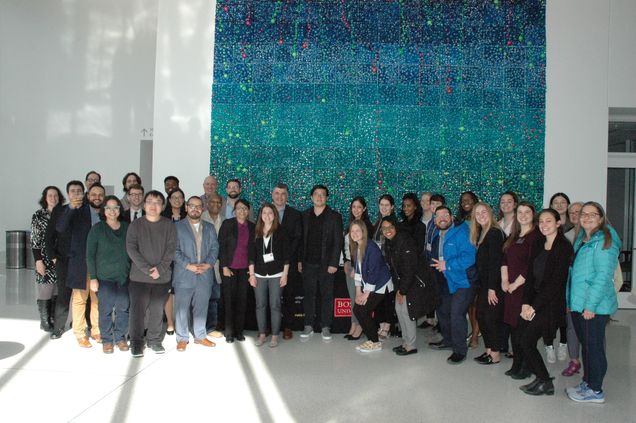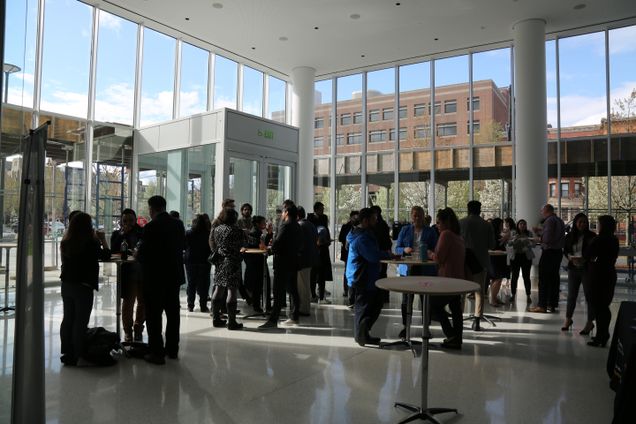BUCPUA Students Address Transit Oriented Development at Capstone Presentations

On Saturday, April 27, 2019 BUCPUA students in the Urban Studies Capstone class presented their final capstone presentations to their peers, BUCPUA faculty, and guests. Throughout the semester, students worked in teams to build a project relating to current Boston issues, working towards real solutions for everyday planning problems. The capstone presentations are the culmination of the student’s time in BUCPUA and they proudly presented on their passions.
Dr. Madhu Dutta-Koehler opened the day with her optimism for the students who are on their way to becoming great planners. Dr. Dutta-Koehler thanked the students for their commitment and hard work throughout the semester, reminding them to do right by the people and places they are planning for. Student presentations commenced after Dr. Dutta-Koehler expressed how their “projects [are] to create action-oriented projects that matter.”
Capstone student Matt Smith introduced eight current, sustainable Transit Oriented Development (TOD) projects in the Greater Boston Area before handing the floor over to the first capstone group.
The first presentation discussed concerns for the lack of connectivity of Newton’s Riverside Station with the surrounding village. Students researched ways to prioritize a Transit Oriented Development through multi-modal access in the station. The group recommended creating marked bike lanes, repairing sidewalks, removing on-street parking, installing more street lights, and creating more frequent and reliable bus lines. Their main concern with this project was the financial feasibility of creating more bus routes.

The next group presented on ways to maximize the use of public transportation for work-related trips. The presentation suggested that Newton shift the current development paradigm over to creating a regional development strategy, locating more residencies closer to job opportunities. The group specifically researched regional commuting behaviors — an average commute on the MBTA from Riverside is 56 minutes — and the implementation of a Transit Oriented Development.
The last presentation on Newton argued for community connectivity in Riverside using mode shift and site design. The area is a typical suburban development where one needs a car to get to transit sites, classifying Riverside as a Transit Adjacent Development (TAD) without amenities, rather than a Transit Oriented Development. The group posed the question: How do we reconfigure a TAD to make a TOD and achieve connective community in auto dependent places? The group’s recommendations to achieve this include eliminating parking minutes, locating the station at a focal point, and redesigning Groves Street. The goal is to combine multimodal physical entities with social human interactions to create community connectivity among people who do not know each other personally.
The next set of presentations emphasized plans for Malden’s accessibility and employment. The first presentation focused its concerns on Malden’s employment of the “missing middle,” explaining how many Malden residents are educated but below the poverty line. The group created a workforce development plan with substantial reasoning for potential aerospace industry jobs. The group discussed how a commercial street corridor framework plan with economic and transportation development can maximize employment benefits for Malden’s missing middle, but would need to be wary of gentrification. The following group focused on the Malden River, proposing actions for community development and connecting residential area to the river.
Another group identified and analyzed the impacts of planning initiatives along the Rutherford Avenue Corridor in Charlestown, Boston. They examined both positive and negative effects ranging from connectivity to land use practices near the corridor. The group then identified gaps between three of the studied plans and addressed neighborhood concerns through policy recommendations.
The following group articulated the impacts of Transit Oriented Development on public health as an understudied topic. Their research evaluated the Hood Park Project in Charlestown,

MA in terms of TOD practices that are known to have a positive impact on public health. The group then developed recommendations to address the two gaps in the environmental impacts of the development’s framework — including the heat island effect and vehicle emissions. Recommendations included improvements to tree canopy coverage, square footage of parks, walkability, bikeability, and access to transit. These infrastructure improvements to Hood Park can increase public health benefits for residents of Charlestown.
The final group presented their development project pathway for Charlestown to integrate affordable housing units. The group closely studied the design of affordable housing in the Hood Park development, the Sullivan Square Design Project, and the Beacon Yards redevelopment. The recommendations made by students promote equity and diversity in Charlestown.
After the final presentation, there was a reception to celebrate student’s final course achievements and Collin Yip, founder of Rafi Properties and BU alumnus, handed out Certificates of Appreciation to graduating UPA Officers. Students, faculty, and guests mingled over the presentations and exciting next step of the BUCPUA program.
After an insightful night, students are now able to use what they have learned outside of the classroom, implementing their ideas into the world. As Dr. Madhu Dutta-Koehler had stated in the beginning of the evening, “the time to act is now [and] in the end, knowledge has its applications.”
Delanie Fico, CAS ’21